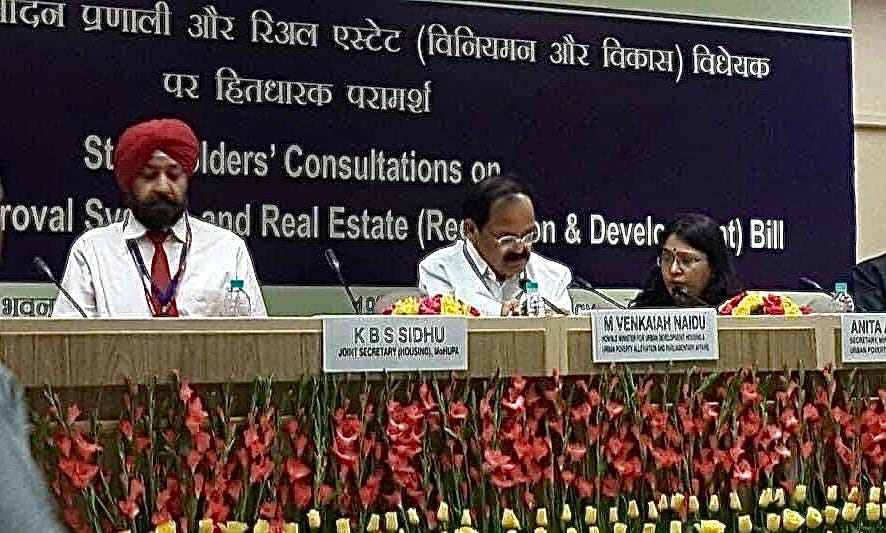10 Myths of RERA Act, 2016
Dispelling Myths and Unravelling the Real Estate (Regulation and Development) Act, 2016 - A Live Broadcast on Facebook.
Dispelling Myths and Unravelling the Real Estate (Regulation and Development) Act - A Live Broadcast on Facebook
Note: The following transcript is extracted, with minimal changes, from a speech that was broadcast LIVE! on Facebook on May 6th, 2017.1
EPILOGUE: Dispelling Persistent Myths - The Ever-Relevant Real Estate (Regulation and Development) Act, 2016.
It is hard to believe that over six years have passed since my Facebook LIVE! talk on May 6, 2017, where we delved into the intricacies of the Real Estate (Regulation and Development) Act, popularly known as RERA. As we all know, the Act became fully operational on May 1, 2017, and since then, the Real Estate Authorities have been functioning in all states across the country.
Despite the passage of time and the effective implementation of RERA, it is both surprising and disheartening to acknowledge that some of the misconceptions I addressed on that memorable day, within a week of RERA being fully implemented, persist to this day. As a result, I find it pertinent to re-share the key points discussed during the broadcast, hoping that they serve as a beacon of clarity for all stakeholders in the real estate sector.
Introduction: Shedding Light on Misconceptions
Good evening, friends!
As we had promised, and as we had mentioned in our previous post, today we will be discussing the Real Estate (Regulation and Development) Act of 2016, commonly known as RERA. The purpose of this discussion is to address and debunk some of the prevailing myths that exist among consumers and builders regarding this Act. It is important to shed light on these misconceptions because, despite the Act being notified and gazetted after being passed by both Houses of Parliament in March of the previous year (2016), there are still certain sections that require clarification. Additionally, the Act had allowed time for various State Governments to establish the necessary infrastructure and regulatory bodies, such as the Housing Regulator, to effectively implement the provisions of RERA. Therefore, the objective of our talk today is to dispel some of these myths that may not be apparent at first glance but hold significant importance in understanding the nuances of this legislation.
Background: The Genesis of RERA
During my tenure as the Joint Secretary, Housing in the Ministry of Housing and Urban Poverty Alleviation (HUPA) from August 2013 to early 2015, I had the opportunity to work closely on the development and progress of this Act. At that time, the UPA Government, led by Sardar Manmohan Singh, was in power, and the Minister-in-charge of HUPA was Madam Girija Vyas from Rajasthan.
After the Modi Government came into power in May 2014, Mr. Venkaiah Naidu took over as the Minister of Housing and Urban Development, merging the previously separate ministries. Throughout the process of developing the Act, there were extensive consultations with various stakeholders, including builder lobbies, consumer organizations, legal experts, and Joint Parliamentary Committees. These consultations aimed to ensure that the Act addresses the concerns and perspectives of all parties involved. I had the privilege to witness and contribute to these discussions before moving on to my promotion as Additional Secretary, Government of India.
Balancing Perspectives: Striking a Middle Ground
One of the main arguments put forth by the builder lobby during the development of the Act was that the real estate sector was already burdened with excessive regulations and clearances. They contended that obtaining the multitude of necessary clearances, such as land title certifications, changes in land use, compliance with safety norms, and environmental clearances, was an arduous task. This led to a prevalence of unscrupulous fly-by-night operators who disregarded statutory provisions and legal requirements. On the other hand, consumer organizations vehemently argued that the real estate sector, being a significant investment for individuals, necessitated robust regulations to protect consumers from fraudulent practices. Thus, a balance had to be struck between these competing viewpoints.
Formulating RERA: Finding the Equilibrium
Throughout the development of the Act, there were divergent opinions on the level of regulation required. Some advocated for a toothless Act that merely establishes a regulator without significant enforcement powers. Others sought a more stringent Act that could potentially lead to imprisonment for non-compliance. The challenge was to find a middle ground that ensures compliance while also facilitating the growth and development of the real estate sector. I recall a conversation with our Minister, Mr. Venkaiah Naidu, who emphasized the need for regulation without strangulation. Various real estate organizations, including the National Real Estate Development Council (NAREDCO) and the real estate wing of the Confederation of Indian Industry (CII), were also engaged in the discussions. The Ministry of Urban Development, among others, played a crucial role in shaping the Act.
Debunking Myths: Addressing Key Misconceptions about RERA
Now that the Act is in effect and the regulatory bodies are being established, it is important to address the prevailing myths and misconceptions about RERA. We will systematically tackle these myths to provide a clearer understanding of the Act's provisions and their implications.
Myth 1: Additional Permissions and Compliance Burden
The first myth propagated by the builder lobby is that RERA adds additional permissions and increases compliance burden. However, this is not the case. The Act clearly states that it does not introduce any new permissions or requirements. Builders are still required to obtain all the necessary clearances and permissions as mandated by existing laws and regulations. What the Act stipulates is that builders must register their projects with the housing regulator by submitting all the required permissions and clearances. This registration is a crucial step that brings transparency and accountability to the real estate sector. The aim is to ensure that the builder has all the necessary approvals in place before commencing a project, and this information is made available to the public through an online process. Importantly, if the regulator fails to make a decision within a specific timeframe, the approval is deemed granted. Hence, the Act does not increase the compliance burden but instead streamlines the registration process while ensuring accountability.
Myth 2: Further Delay in Projects
The second myth revolves around the notion that RERA will further delay projects. This misconception arises from a misunderstanding of the Act's provisions. RERA does not impose any new restrictions on starting development work. Builders can initiate development activities if they have obtained the necessary permissions as required by the local laws. RERA comes into effect when the project involves public money, be it through pre-sales or loans from financial institutions. The Act ensures that before a builder involves public funds, they have the requisite permissions in place to protect the interests of consumers and prevent undue delays. The objective is to promote timely completion of projects while safeguarding the rights of homebuyers.
Myth 3: Guaranteed Quality of Construction
Another prevalent myth is that RERA guarantees the quality of construction and specifications. While it is true that the Act emphasizes transparency and accountability, it does not lay down specific quality standards. Builders are obligated to specify the quality standards in their registration application and are bound to deliver what they have promised. Whether it is high-end specifications or more modest ones, the Act ensures that builders fulfill their commitments and deliver the promised quality. It is important for consumers to carefully review the specifications provided by builders before making purchasing decisions.
Myth 4: Specific Time Limit for Project Completion
Timely completion of projects has always been a concern for homebuyers. RERA, however, does not establish a specific time limit for project completion. Instead, it places the onus on the builder to define the expected timeline for project delivery and include it in the registration application. Once the builder sets the time limit, they are contractually obligated to adhere to it. However, the Act does allow for certain extensions under exceptional circumstances, although regulators are expected to grant them sparingly and on valid grounds.
Myth 5: Diversion of Funds
One of the key aspects addressed by RERA is the issue of diversion of funds from one project to another. To tackle this problem, the Act mandates builders to maintain a separate account for each project. This requirement ensures that the funds collected from homebuyers for a specific project are utilized exclusively for that project, minimizing the risk of fund diversion and enhancing transparency in financial transactions.
A Balanced Approach: Obligations for Consumers and Dispute Resolution
Critics of the Act argue that it is one-sided and places all the obligations on builders, neglecting the responsibilities of consumers. However, it is essential to note that RERA also outlines certain obligations for consumers. The Act promotes a balanced approach that holds builders accountable for their commitments while simultaneously ensuring compliance with the law by consumers. By establishing a regulatory framework, RERA aims to create a level playing field for all stakeholders involved in the real estate sector.
In terms of dispute resolution, RERA establishes adjudicating officers who are responsible for handling individual consumer grievances. The Act provides provisions for compensation and damages in case of any issues related to the product or service. Additionally, a single Appellate Tribunal is set up to hear appeals from both consumers and promoters, further streamlining the dispute resolution process. In the event of non-compliance with the Act, the regular legal procedures and judicial courses are followed.
Real Estate Agents: Registration and Consumer Protection
RERA also addresses the registration of real estate agents. It mandates the registration of agents to ensure their qualifications, professionalism, and adherence to a code of conduct. This registration process enables consumers to make informed decisions while choosing registered salespersons, thereby reducing the risk of engaging with unscrupulous or unauthorized agents.
Conclusion: The Role of RERA in Fostering Trust
In conclusion, the Real Estate (Regulation and Development) Act aims to make builders accountable and ensure they deliver what they promise to consumers. It is not designed to imprison builders but rather to enforce compliance with the Act's provisions. The Act incorporates penalties, compensation, and damages to ensure adherence to the regulations. Criminal prosecution is pursued only in extreme cases where intentional fraud or grave violations occur. RERA strikes a balance between the interests of all stakeholders involved in the real estate sector.
While the Act represents a significant step forward, it is important to acknowledge that it is not a panacea for all the challenges faced by the real estate sector. It serves as an important tool for addressing key issues and establishing a regulatory framework, but other complementary measures are also necessary. The state governments are in the process of framing rules and regulations to implement the Act effectively, and most states have already begun this process.
Thank you all for joining me today. If you have any questions, I will be happy to answer them now, or you can message me privately.
https://www.facebook.com/kbs.sidhu/videos/10154759697822779/?mibextid=cr9u03









